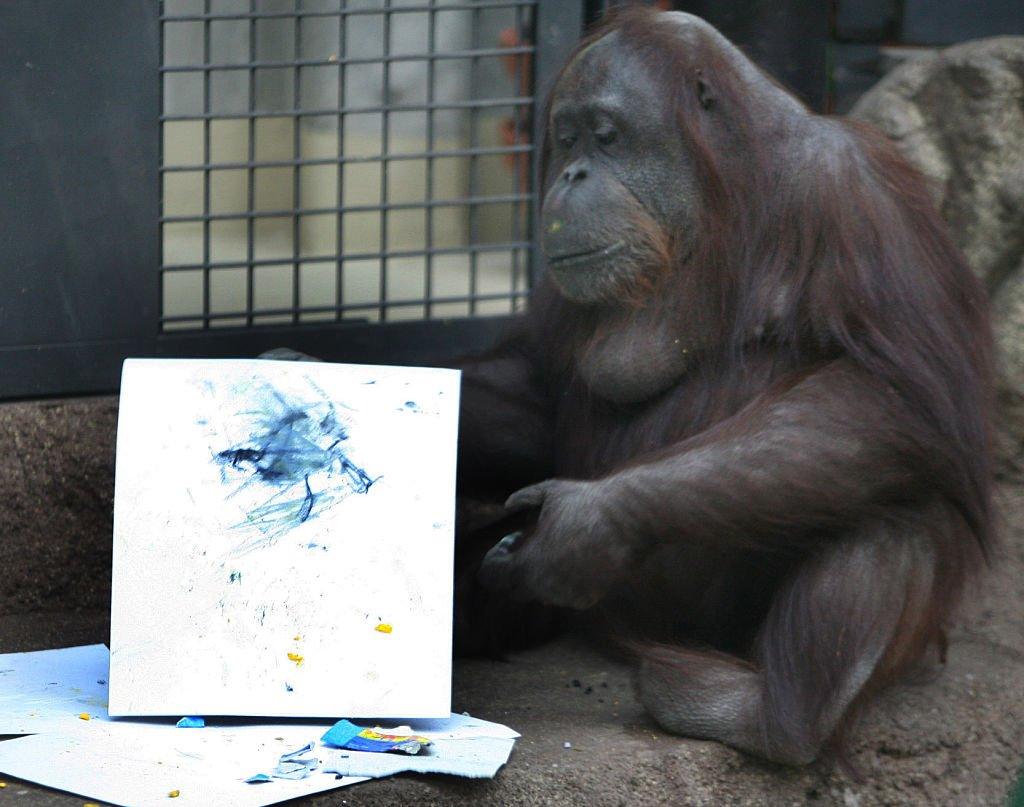Is your artwork similar to an orangutan's?
- Published
- comments

This female orangutan, called Gypsy, looks pretty proud of her effort!
Have you still got any drawings you made when you were little? You know the type - some colourful scribbles you did on a piece of paper... well, it turns out your artwork might not be that different from an orangutan's!
OK, your paintings and drawings might be a little more detailed now, but a new study of five orangutans at a Japanese zoo has shown that their art is inspired by similar things to humans.
The study found that the drawings - especially those of one orangutan called Molly - changed to reflect differences in things like the weather and seasons, life events and meeting new people, such as zoo keepers.
For example the study found that the orangutans tended to use purple in the spring and green in the summer and winter.
The study into the orangutan drawings began after ape expert C茅dric Sueur, from the University Institute of France, watched his young daughter drawing. She was scribbling he says, but "as if it had meaning."
C茅dric then wondered if orangutan art could also have meaning.
Orangutans are one of the closest animal relatives to humans - in fact, we share nearly 97% of the same DNA!
DNA is the material that carries all the information about how a living thing will look and function.
The word orangutan comes from the Malay words "orang hutan", meaning "human of the forest".
Female orangutan, Gypsy, draws a picture at Tama zoo outside Tokyo. Her favourite colours are blue and yellow
The study took place at Tama Zoological Park in Japan, where zookeepers regularly provided whiteboards and crayons for their orangutans to draw with.
Drawing is often used as an activity for primates in zoos. Monkeys and apes are known to draw spontaneously, much like human children do.
The five female orangutans at Tama Zoo collectively created almost 1,500 drawings between 2006 and 2016, with Molly producing the most art work.
In total, the researchers looked at 790 of the orangutan drawings, in what is the biggest study into art from apes ever carried out.
Their findings revealed that "the drawing behaviour of these five orangutans is not random and that differences among individuals might reflect differences of styles, states of mind, and motivation to draw."
Molly made more than 1000 drawings in the space of 5 years. She often drew curved lines and shapes, and liked to use green in her summer drawings, like this artwork here
Molly's summer drawings contained more "loops" which researchers think could indicate "a good mood due to the weather and the presence of more visitors," compared to her winter drawings.
From the zookeeper records, the scientists know Molly "took time to draw," Sueur says. "The others (orangutans) would finish very quickly, but she would work on hers for an hour or more at a time," suggesting the experience of creating artwork was different for Molly compared to her fellow apes.
Researchers hope the study can give more of an understanding as to why early humans started painting on cave walls.
They, just like the orangutans, could have been inspired by their surroundings, thoughts and feelings and motivated to paint because it's enjoyable and fun.
What do you think of these orangutan pictures? Don't forget to try our quiz and let us know how you got on in the comments.
Orangutans are red-haired apes that live in the tropical rainforests of Sumatra and Borneo in southeast Asia.
They have a seriously wide arm span - some males can stretch their arms two metres from fingertip to fingertip. That's about the height of a standard door!
These amazing apes generally have long lives - in captivity they can live for 50-60 years.
Orangutans are today on the endangered species list. Deforestation in the forests where they live has reduced their habitat, and illegal hunting has reduced numbers in the wild.
- Published29 November 2019
- Published13 February 2018
- Published6 April 2017
